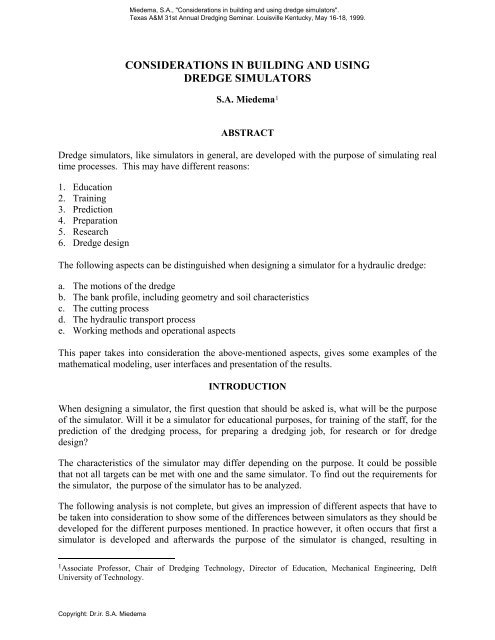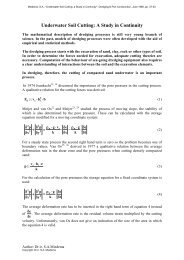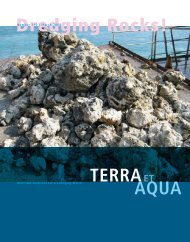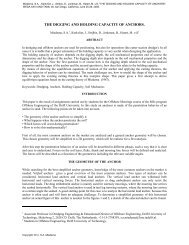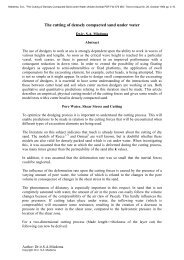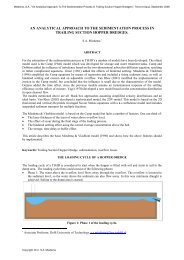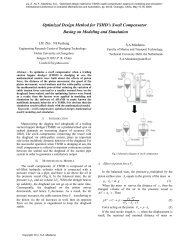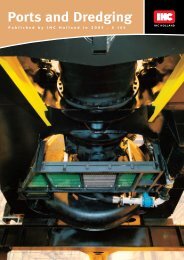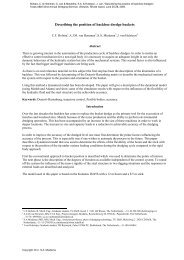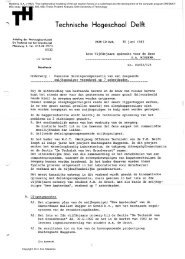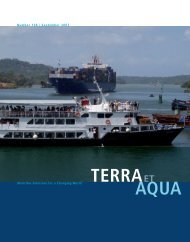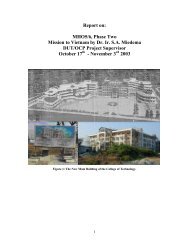Adobe - Dredging Engineering Research Laboratory
Adobe - Dredging Engineering Research Laboratory
Adobe - Dredging Engineering Research Laboratory
- No tags were found...
You also want an ePaper? Increase the reach of your titles
YUMPU automatically turns print PDFs into web optimized ePapers that Google loves.
Miedema, S.A., "Considerations in building and using dredge simulators".Texas A&M 31st Annual <strong>Dredging</strong> Seminar. Louisville Kentucky, May 16-18, 1999.Fig. 2: The display of the winch, operational and slurry parameters.The use of the training simulator requires:1. Console and user interface1.1. The console and the user interface should match those on the dredge1.2. Video facilities should be available1.3. There should be an instructors console1.4. The instructor should be able to monitor the student and influence the dredging process2. Educational program2.1. The educational program focuses on the operational aspects, working methods andproblems that may be encountered during dredging2.2. A well trained instructor is required3. Mathematical modeling3.1. The simulator has to operate real-time3.2. The mathematical modeling of the dredging processes does not have to be detailed, buthas to show correct tendencies3.3. The mathematical modeling should focus on operational aspects3.4. The instructor has to be able to interact4. Results and responses4.1. Especially the man-machine interface actions have to be recorded4.2. The display of results and responses should match those on the dredge4.3. The instructor requires additional outputCopyright: Dr.ir. S.A. Miedema
Miedema, S.A., "Considerations in building and using dredge simulators".Texas A&M 31st Annual <strong>Dredging</strong> Seminar. Louisville Kentucky, May 16-18, 1999.3. Mathematical modeling3.1. Detailed mathematical modeling of the dredging processes3.2. Detailed mathematical modeling of the bank3.3. Less detailed modeling of working methods and operations3.4. Possibility to play scripts4. Results and responses4.1. Different parameters as a function of time4.2. Statistical values of different parameters4.3. Detection of dredging limitsThe preparation simulatorThe preparation simulator is considered to be a simulator for preparing dredging projects.Usually when starting a dredging job the operators have to learn how to optimize the workingmethods for that specific job. If it would be possible to carry out this learning process on asimulator, time would be saved.The main targets are:1. Simulate a dredging project2. Speed up the learning curve of a project on site3. Detect possible problemsThe use of the preparation simulator requires:1. Console and user interface1.1. Console and user interface see the training simulator (examples fig. 4 and 5)1.2. Display of survey dataFig. 4: The display of the back view of the cutterdredge, also showing the cross-sectionalchannel profile.2. Educational program2.1. There does not have to be an educational program2.2. Training of the dredge operator on a training simulator is required2.3. Scripts with standardized working methods have to be available2.4. Standardized sets of soil mechanical parameters have to be availableCopyright: Dr.ir. S.A. Miedema
Miedema, S.A., "Considerations in building and using dredge simulators".Texas A&M 31st Annual <strong>Dredging</strong> Seminar. Louisville Kentucky, May 16-18, 1999.3. Mathematical modeling3.1. The simulator has to operate real-time3.2. The mathematical modeling of the dredging processes does not have to be detailed, buthas to show correct tendencies3.3. Survey data of real projects have to be able to be used3.4. The mathematical modeling should focus on operational aspects4. Results and responses4.1. The display of results and responses should match those on the dredge4.2. Additional output in relation to optimization has to be available4.3. Survey data has to be made visibleFig. 5: The display of the side view of the cutterdredge, also showing the longitudinal channelprofile.The research simulatorThe research simulator is considered to be a simulator for carrying out desk research on dredgingprocesses and systems. Basic processes can be solved manually, but as soon as the differentprocesses interact and the system starts behaving dynamically it is preferred to use simulationsoftware. Figures 1 to 6 show a combined user-interface and console, including the script feature.The main targets are:1. Simulating complex process behavior2. Simulating complex system behaviorThe use of the research simulator requires:1. Console and user interface1.1. Console and user interface can be combined on one PC (on-screen console)1.2. The simulator must have the ability to be controlled by scripts1.3. The simulator must have the ability to be controlled manually1.4. An instructors console is not required2. Educational program2.1. There does not have to be an educational program2.2. There has to be a specialist working on a regular basis on the simulator2.3. There has to be a detailed programmers manualCopyright: Dr.ir. S.A. Miedema
Miedema, S.A., "Considerations in building and using dredge simulators".Texas A&M 31st Annual <strong>Dredging</strong> Seminar. Louisville Kentucky, May 16-18, 1999.Fig. 6: The display of the top view of the cutterdredge, also showing the channel.3. Mathematical modeling3.1. Detailed mathematical modeling of the dredging processes3.2. Detailed mathematical modeling of the bank3.3. Detailed mathematical modeling of the dynamics3.4. Less detailed modeling of working methods and operations3.5. The software should be open4. Results and responses4.1. Dedicated, depending on the subject of the research4.2. Output of the input, so the relation input output can be studied4.3. Output of dredging process parameters as a function of time complemented withstatisticsThe dredge design simulatorThe dredge design simulator is considered to be a simulator that predicts system behavior thatcan be used in the design phase of building a dredge. This type of simulator can also be used forthe modification of a dredge for a specific job or for determining the different components andlayout for a specific dredging job (for example the choice of a booster pump).The main targets are:1. Predict complex system behavior2. Optimize dredging limits3. Predict loads on specific parts of the dredgeCopyright: Dr.ir. S.A. Miedema
Miedema, S.A., "Considerations in building and using dredge simulators".Texas A&M 31st Annual <strong>Dredging</strong> Seminar. Louisville Kentucky, May 16-18, 1999.The use of the dredge design simulator requires:1. Console and user interface1.1. Console and user interface can be combined on one PC (on-screen console)1.2. The simulator should be controlled by scripts2. Educational program2.1. There does not have to be an educational program2.2. There has to be a specialist working on a regular basis with the software3. Mathematical modeling3.1. Detailed mathematical modeling of dredging processes3.2. Detailed mathematical modeling of resulting loads3.3. The software has to be reproducible, meaning that one script has reproducible output4. Results and responses4.1. Loads on different parts of the dredge4.2. Time series of the dredging processes4.3. Production information4.4. Detection of limiting conditionsThe motions of the dredgeThe dredge motions consist of the six degrees of freedom of the pontoon complemented with therotation of the ladder around the ladder bearings. This gives a total of 7 degrees of freedom(surge, sway, heave, roll, pitch, yaw and ladder rotation). For a dredge operating in still water,when wave forces are ignored, the motions in the horizontal plane are relevant (surge, sway andyaw) as well as the ladder rotation. The three pontoon motions can be reduced to the rotationaround the spud if the spud is considered to be infinitely stiff. If the ladder rotation is considerednot to be the result of a mass-spring system, but controlled by the ladder winch, only oneequilibrium equation has to be solved, the rotation of the pontoon around the spud. The other 6equilibrium equations are of interest when working offshore, when wave forces have to be takeninto account, but using these equations increases the calculations to be carried out enormous.This may be useful for the training, the preparation and the dredge design simulators foradvanced training. For the educational, the prediction and the research simulator these motionsare not of interest unless they are subject of research.The equilibrium equation of rotation around the spud is a second order non-linear differentialequation, with the following external forces:1. The inertial forces of pontoon and ladder2. The water damping on pontoon and ladder3. The spring forces resulting from the swing wires4. The external forces resulting from the current5. The external forces resulting from the cutting process6. The external forces resulting from the swing winchesCopyright: Dr.ir. S.A. Miedema
Miedema, S.A., "Considerations in building and using dredge simulators".Texas A&M 31st Annual <strong>Dredging</strong> Seminar. Louisville Kentucky, May 16-18, 1999.7. The external forces resulting from the pipeline8. The reaction forces on the spudThe inertial forces (moments) determine whether there is an acceleration or deceleration of therotation around the spud. These forces are the result of the equilibrium equation and thus of theexternal forces.Graph 4 : Winches Time RecordingsName : Dr.ir. S.A. MiedemaCompany : SAM-ConsultSessions : 1Cutter Suction Dredge Simulator V3.02May 26, 1998, 10:32:08 PMDredge: Cutter Suction DredgeCopyRight: SAM-ConsultkNm/minm/minkNPort winch rope force vs time1000800600400200000:00 00:01 00:02 00:03 00:04 00:05 00:06 00:07 00:08 00:09 00:10Time60.036.012.0-12.0-36.0Port winch rope speed vs time-60.000:00 00:01 00:02 00:03 00:04 00:05 00:06 00:07 00:08 00:09 00:10Time60.036.012.0-12.0-36.0Starboard winch rope speed vs time-60.000:00 00:01 00:02 00:03 00:04 00:05 00:06 00:07 00:08 00:09 00:10Time1000800600400200Starboard winch rope force vs time000:00 00:01 00:02 00:03 00:04 00:05 00:06 00:07 00:08 00:09 00:10TimeFig. 7: The output of the winch parameters.The water damping and the current forces depend on the value and the direction of the currentand on the rotational speed of the pontoon around the spud.The spring forces resulting from the swing wires and the forces resulting from the swingwinches, strongly depend on the characteristics of the winches and the wires and the winchcontrol system. The position of the anchors in relation to the position of the spud and theposition of the swing wire sheaves on the ladder determines the direction of the swing wireforces and thus of the resulting moments around the spud. Figure 7 shows the winch output of aresearch simulator.The forces resulting from the pipeline can be neglected if the position of the swivel elbow isclose to the position of the work spud, because in this case this force hardly influences therotation of the pontoon around the spud.The cutting forces and the cutting torque strongly influence the rotation around the spud, thesewill be discussed in the paragraph cutting forces.Copyright: Dr.ir. S.A. Miedema
Miedema, S.A., "Considerations in building and using dredge simulators".Texas A&M 31st Annual <strong>Dredging</strong> Seminar. Louisville Kentucky, May 16-18, 1999.The reaction forces on the spud can be determined by the equilibrium equations of forces andcomplement this equilibrium.The rotation of the pontoon around the spud is dominated by the cutting forces, the winchcharacteristics, the inertia of pontoon and ladder and placement of the anchors, while dampingand current play a less important role.The equilibrium equation in question is non-linear, while some of the data is produced byinterpolation from tables. This implies that the equation will have to be solved in the timedomain, using a certain time step. This is also necessary because the simulation program has tointeract with the console (the user input). To simulate the motions of the dredge real time, a timestep of at least two times per second is required. A time step of 5 to 10 times per second wouldbe preferred.The bank profileIn the modeling of the bank the following aspects can be distinguished:1. The storage method and resolution2. The geometry input and presentation of the geometry3. The number of different soils allowed and the soil mechanical parameters4. The wall velocity5. Cave ins6. Updating the geometryThe storage method should be the result of the other 5 aspects, but depending on the computersystem used, the storage of the bank profile may use a lot of disk space and use a lot of CPUtime. Fortunately the development of computers is going very fast, resulting in cheap multi GBcapacity hard disks and very fast CPU’s. The bank can be stored as a large matrix (in an array),with one subscript representing the width of the area covered and the other subscript representingthe length. The value of each element of the matrix represents the height. If the with is 200 mand the length 1000 m, then a resolution of 1 m gives 200.000 points. If the height is stored as afloating-point variable of 4 bytes, this requires about 100 kB, which is not a problem with respectto storage. With a resolution of 0.1 m this requires 10 MB, which was a problem 5 years ago.The resolution required can however be determined from the cutting process. The swing velocitywill be about 0.3 m/s under normal operating conditions. With a time step of 0.5 seconds, thecutterhead has moved 0.15 m in one timestep. With a time step of 0.1 second, the cutterhead hasmoved only 0.03 m in one time step. This results in a resolution of 0.01 m, which requires 1 GBof storage and increases the CPU time, since the movement of the cutterhead should always belarger then the resolution. A compromise between time step and resolution has to be chosen.There may be more sophisticated ways to store the bank, but they will usually result in othercompromises.Figure 8 shows a 3D picture of the bank, the matrix structure is visible.Copyright: Dr.ir. S.A. Miedema
Miedema, S.A., "Considerations in building and using dredge simulators".Texas A&M 31st Annual <strong>Dredging</strong> Seminar. Louisville Kentucky, May 16-18, 1999.Fig. 8: A 3D view on the channel profile.The geometry input should be easy, for instance through a mesh of triangles. Another option is,to use existing survey data to generate a bank. In this case a conversion utility has to beavailable. The possibility of using existing survey data is especially important for the preparationsimulator and also for the training simulator. The geometry presentation is preferred to be 3D,with the possibility to view the geometry from different directions and to zoom in and out. If thebank profile is stored in an independent file, the user has the possibility to write his own bankgenerating programs.The bank can consist of one type of soil, however to simulate more closely to reality, it ispreferred to be able to create a bank consisting of more types of soil. This way layers of differentmaterial, like gravel beds or clay layers can be simulated. Since the resolution of these differenttypes of soil does not have to be so fine as the resolution of the bank, it would be a waste ofstorage space to store the soil data in the bank file. Storing this data in a separate file is preferred.This allows for an almost infinite number of soils.The soil mechanical parameters depend on the type of soil. At least sand and clay should beimplemented. By storing the soil types in a database and referring to the record number of thesoil type in question, one can use different soils and define standard soil types.Resuming there are 3 storage files required, one for the geometry of the bank profile, which canbe a very large file, one for the storage of the geometry of layers of different types of soil andone for the storage of the soil mechanical parameters.The wall velocity and cave ins are two physical processes that occur independent from themotions of the dredge. Although the dredging process can induce these phenomena, they do nothave to occur at the position of the cutterhead and at the same time the cutterhead is at thatposition. The occurrence of material flowing down on the slopes, depends on the type of materialand on the slope angle. The occurrence of cave ins depends on the stability of a slope and thusalso on the material properties. With respect to time these phenomena occur almost independentCopyright: Dr.ir. S.A. Miedema
Miedema, S.A., "Considerations in building and using dredge simulators".Texas A&M 31st Annual <strong>Dredging</strong> Seminar. Louisville Kentucky, May 16-18, 1999.from the dredging process. This requires a second time loop to check for the possible occurrence,determine the displacement of material and update the geometry matrix. It is obvious that theCPU time required is inversely proportional to the resolution of the matrix.This matrix will have to be updated every timestep, when the cutterhead has excavated a certainvolume of soil. As mentioned before, the displacement of the cutterhead has to be bigger then theresolution of the matrix, otherwise it is difficult to determine the excavated volume. The matrixonly has to be updated for the area covered by the projected area of the cutterhead. A volumebalance between excavated volume and hydraulically transported volume can be taken as averification tool.The cutting processOne of the main processes of the cutter dredge is the cutting process. The cutterhead has twofunctions, excavating the soil and mixture forming. The hydraulic transportation process has thefunction to transport the mixture to its destination.Graph 5 : Cutter Time RecordingsName : Dr.ir. S.A. MiedemaCompany : SAM-ConsultSessions : 1Cutter Suction Dredge Simulator V3.02May 26, 1998, 10:32:08 PMDredge: Cutter Suction DredgeCopyRight: SAM-ConsultrpmkNmdeg.mCutter speed vs time50.040.030.020.010.00.000:00 00:01 00:02 00:03 00:04 00:05 00:06 00:07 00:08 00:09 00:10Time800640480320160Cutter torque vs time000:00 00:01 00:02 00:03 00:04 00:05 00:06 00:07 00:08 00:09 00:10Time905418-18-54Swing angle vs time-9000:00 00:01 00:02 00:03 00:04 00:05 00:06 00:07 00:08 00:09 00:10Time100-10-20-30Cutter depth vs time-4000:00 00:01 00:02 00:03 00:04 00:05 00:06 00:07 00:08 00:09 00:10TimeFig. 9: The output of cutter position, speed and torque.In dredging there is a variety of types of soil to be excavated. Therefore the types of soil aregrouped into sand, clay and rock, knowing that this does not cover all the possibilities. Since forsolving the equilibrium equations around the spud, the cutting forces need to be known, a cuttingmodel for each type of material has to be implemented, using the soil mechanical and operationalparameters as input. Cutting models can be very detailed or global. To determine how detailedthe cutting model has to be, the time involved in the detailed cutting process should be comparedto the time frame of the motions of the dredge. The time frame of the motions of the dredge canCopyright: Dr.ir. S.A. Miedema
Miedema, S.A., "Considerations in building and using dredge simulators".Texas A&M 31st Annual <strong>Dredging</strong> Seminar. Louisville Kentucky, May 16-18, 1999.be characterized by the Eigen frequency of the motions of the dredge around the spud. ThisEigen frequency is usually 10 to 20 seconds and gives an indication of the speed with which thedredge responds to changes of the loads (forces and moments) on the dredge. Figure 9 shows theresults of the cutterhead modeling.The cutting process consists of high frequent cutting of small pieces of soil that break out everyfew centimeters. With a circumferential cutting speed of several meters per second, this gives afrequency of 50 to 500 pieces per second. The resulting cutting forces will fluctuate around someaverage with this frequency. It is obvious, that the motions of the pontoon will not be influencedby such high frequency varying forces. The frequency with which cutter blades hit the bank isaround 2 to 4 per second. This frequency is also to high to influence the motions of the dredge.Implementing both the forces resulting from pieces breaking out and forces resulting from theblades hitting the bank will cause a tremendous increase in CPU time, without a noticeable effecton the motions of the dredge. The low frequent force variations resulting from a change in theaverage forces on the cutterhead due to variations in swing speed and variation of the soil to beexcavated will influence the motions of the dredge. Those forces should be used in themathematical model as implemented in simulators. Only the research simulator may requiremore detailed modeling of the cutting forces if these are the subjects of the research.The hydraulic transport processThe hydraulic transport system consists of a multi pump pipeline system (ladder-, main- andbooster pump). The pumps are diesel direct or diesel electrical driven. In short, the excavated soilis mixed with water inside the cutterhead and transported through the hydraulic system. Since theexcavating process is not stationary, the mixture density, the soil mechanical parameters and thedredging depth all at the position of the cutterhead may vary in time, the mixture density and thesoil mechanical parameters will also vary over the length of the pipeline. This results in avarying resistance and thus pressure loss over the length of the pipeline and in time, causing thepump drive to have varying revolutions and the pumps to have varying discharge pressures.Since the mixture travels through the pipeline these effects will occur at different times for thesubsequent pumps.Resuming it can be stated that the hydraulic transport process is a very dynamical process. Themathematical model of this process should consist of at least a mass, spring, damper modelwhere the torque/revolutions behavior of the pump drive gives input for the external load. Themoments of inertia of pump drive, pump and the mass of the mixture in the pipeline give thetotal mass; the pressure drop in the pipeline gives the damping, while the control system (flowcontrol or diesel injection control) results in spring behavior. The diesel engine behaves howeveras a second order system, which makes the modeling more complex. To be able to determine thepipeline resistance at every position in the pipeline, it is necessary to know the mixture densityand soil mechanical parameters at every position in the pipeline. Since the mixture is movingthrough the pipeline, a bookkeeping system is required. Then at each small pipe segment theresistance can be determined with Durand, Fuhrboter, Wilson or another model. The totalresistance action on a pump can be determined by integration. The number of segments (and thusthe size of one segment) determines the CPU time. For the research simulator the segment sizeshould be small.Copyright: Dr.ir. S.A. Miedema
Miedema, S.A., "Considerations in building and using dredge simulators".Texas A&M 31st Annual <strong>Dredging</strong> Seminar. Louisville Kentucky, May 16-18, 1999.Total Head in kPaPressure in kPa4400396035203080264022001760132088044000.00 0.40 0.80 1.20 1.60 2.00 2.40 2.80 3.20 3.60 4.00Flow in m^3/sec190015001100700300Stationary Pump Behaviour Windows V3.00 - Torque Limited:03-20-1999 - 13:43:32C:\WIN311~1\CSDS\Pipeline\Pipeline.001 in Default SandVcrit Water Rho: 1.124 Rho: 1.218 Rho: 1.312 Rho: 1.406 Rho: 1.500Prod. in m^3/hourFlow in m^3/secProd. in m^3/hour01.0 1.2 1.4 1.6 1.8 2.0Density in ton/m^3Total Power in kW12000960072004800240001.0 1.2 1.4 1.6 1.8 2.0Density in ton/m^3-1000 410 820 1230 1640 2050 2460 2870 3280 3690 4100Distance from suction mouth in m500040003000200010004.003.202.401.600.800.00500040003000200010000Fig. 10: The output of the system curves of the pump system.0 1000 2000 3000 4000 5000 6000 7000 8000 9000 10000Length of discharge line in m0 1000 2000 3000 4000 5000 6000 7000 8000 9000 10000Length of discharge line in mAnother modeling problem is pump cavitation. One way of modeling this is, to let the mixturedensity in the pump decrease as soon as the pump starts cavitating. By letting this densitydecrease proportional to the time the pump is cavitating the behavior of a cavitating pump can besimulated, because the discharge pressure of a pump is proportional to the mixture density in thepump. Figure 11 gives a good example of the dynamics of the hydraulic transport process, whilefigure 12 shows the resulting production parameters.In general the CPU time required for the hydraulic transport model can be influenced by theaccuracy of the calculations (the number of segments, the number of points on the Q-H curve,etc) and not by the physics of the modeling.Working methods and operational aspectsThe following aspects are important:1. Hoisting and lowering the ladder2. Hoisting and lowering the spuds3. Stepping in the traditional way4. Stepping with a spud carriage5. Starting and stopping the pump drives6. Controlling the pump revolutions7. Starting and stopping the cutter driveCopyright: Dr.ir. S.A. Miedema
Miedema, S.A., "Considerations in building and using dredge simulators".Texas A&M 31st Annual <strong>Dredging</strong> Seminar. Louisville Kentucky, May 16-18, 1999.8. Controlling the cutter revolutions9. Controlling the swing winches10. Moving the anchors11. Flow control12. Etc.Company : SAM-ConsultSessions: 1Graph 2Name: Main Pump Time Recordings: D r.i r. S.A. MiedemaCutter Suction Dredge Simulator V3.02May 26, 1998, 10:32:08 PMDredge: Cutter Suction DredgeCopyRight: SAM-ConsultrpmkWkPakPa500400300200100Main pump speed vs time000:00 00:01 00:02 00:03 00:04 00:05 00:06 00:07 00:08 00:09 00:10Time60004800360024001200Main pump power vs time000:00 00:01 00:02 00:03 00:04 00:05 00:06 00:07 00:08 00:09 00:10Time1006020-20-60Main pump vacuum vs time (-=vacuum, +=pressure)-10000:00 00:01 00:02 00:03 00:04 00:05 00:06 00:07 00:08 00:09 00:10Time200016001200800400Main pump discharge pressure vs time000:00 00:01 00:02 00:03 00:04 00:05 00:06 00:07 00:08 00:09 00:10TimeFig. 11: The output of the most important pump parame ters for the main pump of a cutterdredge.Since a student can interact with the simulator at any time, the simulator has to be able to handlethis. Most of the above aspects do not give an immediate response in reality, but respond like afirst or second order system, so there is a time lap between the action of the student and thereaction of the dredge. This is especially important for the training and the preparation simulator.ConclusionsThe development of simulators is not just a matter of hardware and software, but should begoverned by the use and the targets one wants to achieve. Without a proper ‘educationalprogram’ a simulator is useless. Only the research simulator can do without, because usually theresearcher is often the developer and knows what to do with the simulator. The complexity of themathematical modeling depends on the use of the simulator.Resuming one can state that a simulator, including hardware, software and educational ortraining program, can be considered one entity.Copyright: Dr.ir. S.A. Miedema
Miedema, S.A., "Considerations in building and using dredge simulators".Texas A&M 31st Annual <strong>Dredging</strong> Seminar. Louisville Kentucky, May 16-18, 1999.Graph 1 : P ro duction Time RecordingsNam e : D r.i r. S.A. MiedemaCom pany : SAM-ConsultSess ions : 1Cutter Suction Dredge Simulator V3.02May 26, 1998, 10:32:08 PMDredge: Cutter Suction DredgeCopyRight: SAM-Consultton/m^3m/secm/minm^3/hrSlurry density vs time2.01.81.61.41.21.000:00 00:01 00:02 00:03 00:04 00:05 00:06 00:07 00:08 00:09 00:10TimeSlurry velocity vs time10.08.06.04.02.00.000:00 00:01 00:02 00:03 00:04 00:05 00:06 00:07 00:08 00:09 00:10Time603612-12-36Swing speed vs time-6000:00 00:01 00:02 00:03 00:04 00:05 00:06 00:07 00:08 00:09 00:10Time90007200540036001800Production rate vs time000:00 00:01 00:02 00:03 00:04 00:05 00:06 00:07 00:08 00:09 00:10TimeFig. 12: The output of the most important production parameters.ReferencesKoning, J. de, Miedema, S.A., & Zwartbol, A., "Soil/Cutterhead Interaction under WaveConditions". Proc. WODCON X, Singapore 1983.Miedema, S.A., "Calculation of the Cutting Forces when Cutting Water Saturated Sand". BasicTheory and Applications for 3-D Blade Movements and Periodically Varying Velocitiesfor, in <strong>Dredging</strong> Commonly used Excavating Means. Ph.D. Thesis, Delft University ofTechnology, September 15th 1987.Miedema, S.A., "On the Cutting Forces in Saturated Sand of a Seagoing Cutter Suction Dredge".Proc. WODCON XII, Orlando, Florida, USA, April 1989. This paper was given theIADC Award for the best technical paper on the subject of dredging in 1989.Miedema, S.A., "On the Cutting Forces in Saturated Sand of a Seagoing Cutter Suction Dredge".Terra et Aqua No. 41, December 1989, Elseviers Scientific Publishers.Miedem a, S.A. & Journee, J.M.J. & Schuurmans, S., "On the Motions of a Seagoing CutterDredge, a Study in Continuity ". Proc. WODCON XIII, Bombay, India, 1992.Becker, S. & Miedema, S.A. & Jong, P.S. de & Wittekoek, S., "On the Closing Process ofClamshell Dredges in Water Saturated Sand". Proc. WODCON XIII, Bombay, India,1992. This paper was given the IADC Award for the best technical paper on the subjectof dredging in 1992.Becker , S. & Miedema, S.A. & Jong, P.S. de & Wittekoek, S., "The Closing Process ofClamshell Dredges in Water Saturated Sand". Terra et Aqua No. 49, September 1992,IADC, The Hague.Copyright: Dr.ir. S.A. Miedema
Miedema, S.A., "Considerations in building and using dredge simulators".Texas A&M 31st Annual <strong>Dredging</strong> Seminar. Louisville Kentucky, May 16-18, 1999.Miedema, S.A. & Becker, S., "The Use of Modeling and Simulation in the <strong>Dredging</strong> Industry, inParticular the Closing Process of Clamshell Dredges", CEDA <strong>Dredging</strong> Days 1993,Amsterdam, Holland, 1993.Miedema, S.A., "On the Snow-Plough Effect when Cutting Water Saturated Sand with InclinedStraight Blades". ASCE Proc. <strong>Dredging</strong> 94, Orlando, Florida, USA, November 1994.IHC-Systems & Miedema, S.A., “CSDS Cutter Suction Dredge Simulator”. Delft, 1994.Miedema, S.A., "Production Estimation Based on Cutting Theories for Cutting Water SaturatedSand". Proc. WODCON IV, November 1995, Amsterdam, The Netherlands 1995.Miedema, S.A., "Modeling and Simulation of the Dynamic Behavior of a Pump/PipelineSystem". 17th Annual Meeting & Technical Conference of the Western <strong>Dredging</strong>Association. New Orleans, June 1996.Copyright: Dr.ir. S.A. Miedema
Bibliography Dr.ir. S.A. Miedema 1980-20101. Koert, P. & Miedema, S.A., "Report on the field excursion to the USA April 1981"(PDF in Dutch 27.2 MB). Delft University of Technology, 1981, 48 pages.2. Miedema, S.A., "The flow of dredged slurry in and out hoppers and the settlementprocess in hoppers" (PDF in Dutch 37 MB). ScO/81/105, Delft University ofTechnology, 1981, 147 pages.3. Miedema, S.A., "The soil reaction forces on a crown cutterhead on a swellcompensated ladder" (PDF in Dutch 19 MB). LaO/81/97, Delft University ofTechnology, 1981, 36 pages.4. Miedema, S.A., "Computer program for the determination of the reaction forces on acutterhead, resulting from the motions of the cutterhead" (PDF in Dutch 11 MB).Delft Hydraulics, 1981, 82 pages.5. Miedema, S.A. "The mathematical modeling of the soil reaction forces on acutterhead and the development of the computer program DREDMO" (PDF in Dutch25 MB). CO/82/125, Delft University of Technology, 1982, with appendices 600pages.6. Miedema, S.A.,"The Interaction between Cutterhead and Soil at Sea" (In Dutch).Proc. <strong>Dredging</strong> Day November 19th, Delft University of Technology 1982.7. Miedema, S.A., "A comparison of an underwater centrifugal pump and an ejectorpump" (PDF in Dutch 3.2 MB). Delft University of Technology, 1982, 18 pages.8. Miedema, S.A., "Computer simulation of <strong>Dredging</strong> Vessels" (In Dutch). DeIngenieur, Dec. 1983. (Kivi/Misset).9. Koning, J. de, Miedema, S.A., & Zwartbol, A., "Soil/Cutterhead Interaction underWave Conditions (<strong>Adobe</strong> Acrobat PDF-File 1 MB)". Proc. WODCON X, Singapore1983.10. Miedema, S.A. "Basic design of a swell compensated cutter suction dredge with axialand radial compensation on the cutterhead" (PDF in Dutch 20 MB). CO/82/134, DelftUniversity of Technology, 1983, 64 pages.11. Miedema, S.A., "Design of a seagoing cutter suction dredge with a swell compensatedladder" (PDF in Dutch 27 MB). IO/83/107, Delft University of Technology, 1983, 51pages.12. Miedema, S.A., "Mathematical Modeling of a Seagoing Cutter Suction Dredge" (InDutch). Published: The Hague, 18-9-1984, KIVI Lectures, Section Under WaterTechnology.13. Miedema, S.A., "The Cutting of Densely Compacted Sand under Water (<strong>Adobe</strong>Acrobat PDF-File 575 kB)". Terra et Aqua No. 28, October 1984 pp. 4-10.14. Miedema, S.A., "Longitudinal and Transverse Swell Compensation of a CutterSuction Dredge" (In Dutch). Proc. <strong>Dredging</strong> Day November 9th 1984, DelftUniversity of Technology 1984.15. Miedema, S.A., "Compensation of Velocity Variations". Patent application no.8403418, Hydromeer B.V. Oosterhout, 1984.16. Miedema, S.A., "Mathematical Modeling of the Cutting of Densely Compacted SandUnder Water". <strong>Dredging</strong> & Port Construction, July 1985, pp. 22-26.17. Miedema, S.A., "Derivation of the Differential Equation for Sand Pore Pressures".<strong>Dredging</strong> & Port Construction, September 1985, pp. 35.18. Miedema, S.A., "The Application of a Cutting Theory on a <strong>Dredging</strong> Wheel (<strong>Adobe</strong>Acrobat 4.0 PDF-File 745 kB)". Proc. WODCON XI, Brighton 1986.19. Miedema, S.A., "Underwater Soil Cutting: a Study in Continuity". <strong>Dredging</strong> & PortConstruction, June 1986, pp. 47-53.
20. Miedema, S.A., "The cutting of water saturated sand, laboratory research" (In Dutch).Delft University of Technology, 1986, 17 pages.21. Miedema, S.A., "The forces on a trenching wheel, a feasibility study" (In Dutch).Delft, 1986, 57 pages + software.22. Miedema, S.A., "The translation and restructuring of the computer programDREDMO from ALGOL to FORTRAN" (In Dutch). Delft Hydraulics, 1986, 150pages + software.23. Miedema, S.A., "Calculation of the Cutting Forces when Cutting Water SaturatedSand (<strong>Adobe</strong> Acrobat 4.0 PDF-File 16 MB)". Basic Theory and Applications for 3-DBlade Movements and Periodically Varying Velocities for, in <strong>Dredging</strong> Commonlyused Excavating Means. Ph.D. Thesis, Delft University of Technology, September15th 1987.24. Bakker, A. & Miedema, S.A., "The Specific Energy of the <strong>Dredging</strong> Process of aGrab Dredge". Delft University of Technology, 1988, 30 pages.25. Miedema, S.A., "On the Cutting Forces in Saturated Sand of a Seagoing CutterSuction Dredge (<strong>Adobe</strong> Acrobat 4.0 PDF-File 1.5 MB)". Proc. WODCON XII,Orlando, Florida, USA, April 1989. This paper was given the IADC Award for thebest technical paper on the subject of dredging in 1989.26. Miedema, S.A., "The development of equipment for the determination of the wear onpick-points" (In Dutch). Delft University of Technology, 1990, 30 pages(90.3.GV.2749, BAGT 462).27. Miedema, S.A., "Excavating Bulk Materials" (In Dutch). Syllabus PATO course,1989 & 1991, PATO The Hague, The Netherlands.28. Miedema, S.A., "On the Cutting Forces in Saturated Sand of a Seagoing CutterSuction Dredge (<strong>Adobe</strong> Acrobat 4.0 PDF-File 1.5 MB)". Terra et Aqua No. 41,December 1989, Elseviers Scientific Publishers.29. Miedema, S.A., "New Developments of Cutting Theories with respect to <strong>Dredging</strong>,the Cutting of Clay (<strong>Adobe</strong> Acrobat 4.0 PDF-File 640 kB)". Proc. WODCON XIII,Bombay, India, 1992.30. Davids, S.W. & Koning, J. de & Miedema, S.A. & Rosenbrand, W.F.,"Encapsulation: A New Method for the Disposal of Contaminated Sediment, aFeasibility Study (<strong>Adobe</strong> Acrobat 4.0 PDF-File 3MB)". Proc. WODCON XIII,Bombay, India, 1992.31. Miedema, S.A. & Journee, J.M.J. & Schuurmans, S., "On the Motions of a SeagoingCutter Dredge, a Study in Continuity (<strong>Adobe</strong> Acrobat 4.0 PDF-File 396 kB)". Proc.WODCON XIII, Bombay, India, 1992.32. Becker, S. & Miedema, S.A. & Jong, P.S. de & Wittekoek, S., "On the ClosingProcess of Clamshell Dredges in Water Saturated Sand (<strong>Adobe</strong> Acrobat 4.0 PDF-File1 MB)". Proc. WODCON XIII, Bombay, India, 1992. This paper was given the IADCAward for the best technical paper on the subject of dredging in 1992.33. Becker, S. & Miedema, S.A. & Jong, P.S. de & Wittekoek, S., "The Closing Processof Clamshell Dredges in Water Saturated Sand (<strong>Adobe</strong> Acrobat 4.0 PDF-File 1 MB)".Terra et Aqua No. 49, September 1992, IADC, The Hague.34. Miedema, S.A., "Modeling and Simulation of <strong>Dredging</strong> Processes and Systems".Symposium "Zicht op Baggerprocessen", Delft University of Technology, Delft, TheNetherlands, 29 October 1992.35. Miedema, S.A., "Dredmo User Interface, Operators Manual". Report: 92.3.GV.2995.Delft University of Technology, 1992, 77 pages.36. Miedema, S.A., "Inleiding Mechatronica, college WBM202" Delft University ofTechnology, 1992.
37. Miedema, S.A. & Becker, S., "The Use of Modeling and Simulation in the <strong>Dredging</strong>Industry, in Particular the Closing Process of Clamshell Dredges", CEDA <strong>Dredging</strong>Days 1993, Amsterdam, Holland, 1993.38. Miedema, S.A., "On the Snow-Plough Effect when Cutting Water Saturated Sandwith Inclined Straight Blades (<strong>Adobe</strong> Acrobat 4.0 PDF-File 503 kB)". ASCE Proc.<strong>Dredging</strong> 94, Orlando, Florida, USA, November 1994.Additional Measurement Graphs. (<strong>Adobe</strong> Acrobat 4.0 PDF-File 209 kB).39. Riet, E. van, Matousek, V. & Miedema, S.A., "A Reconstruction of and SensitivityAnalysis on the Wilson Model for Hydraulic Particle Transport (<strong>Adobe</strong> Acrobat 4.0PDF-File 50 kB)". Proc. 8th Int. Conf. on Transport and Sedimentation of SolidParticles, 24-26 January 1995, Prague, Czech Republic.40. Vlasblom, W.J. & Miedema, S.A., "A Theory for Determining Sedimentation andOverflow Losses in Hoppers (<strong>Adobe</strong> Acrobat 4.0 PDF-File 304 kB)". Proc.WODCON IV, November 1995, Amsterdam, The Netherlands 1995.41. Miedema, S.A., "Production Estimation Based on Cutting Theories for Cutting WaterSaturated Sand (<strong>Adobe</strong> Acrobat 4.0 PDF-File 423 kB)". Proc. WODCON IV,November 1995, Amsterdam, The Netherlands 1995.Additional Specific Energy and Production Graphs. (<strong>Adobe</strong> Acrobat 4.0 PDF-File 145kB).42. Riet, E.J. van, Matousek, V. & Miedema, S.A., "A Theoretical Description andNumerical Sensitivity Analysis on Wilson's Model for Hydraulic Transport inPipelines (<strong>Adobe</strong> Acrobat 4.0 PDF-File 50 kB)". Journal of Hydrology &Hydromechanics, Slovak Ac. of Science, Bratislava, June 1996.43. Miedema, S.A. & Vlasblom, W.J., "Theory for Hopper Sedimentation (<strong>Adobe</strong>Acrobat 4.0 PDF-File 304 kB)". 29th Annual Texas A&M <strong>Dredging</strong> Seminar. NewOrleans, June 1996.44. Miedema, S.A., "Modeling and Simulation of the Dynamic Behavior of aPump/Pipeline System (<strong>Adobe</strong> Acrobat 4.0 PDF-File 318 kB)". 17th Annual Meeting& Technical Conference of the Western <strong>Dredging</strong> Association. New Orleans, June1996.45. Miedema, S.A., "Education of Mechanical <strong>Engineering</strong>, an Integral Vision". FacultyO.C.P., Delft University of Technology, 1997 (in Dutch).46. Miedema, S.A., "Educational Policy and Implementation 1998-2003 (versions 1998,1999 and 2000) (<strong>Adobe</strong> Acrobat 4.0 PDF_File 195 kB)". Faculty O.C.P., DelftUniversity of Technology, 1998, 1999 and 2000 (in Dutch).47. Keulen, H. van & Miedema, S.A. & Werff, K. van der, "Redesigning the curriculumof the first three years of the mechanical engineering curriculum". Proceedings of theInternational Seminar on Design in <strong>Engineering</strong> Education, SEFI-Document no.21,page 122, ISBN 2-87352-024-8, Editors: V. John & K. Lassithiotakis, Odense, 22-24October 1998.48. Miedema, S.A. & Klein Woud, H.K.W. & van Bemmel, N.J. & Nijveld, D., "SelfAssesment Educational Programme Mechanical <strong>Engineering</strong> (<strong>Adobe</strong> Acrobat 4.0PDF-File 400 kB)". Faculty O.C.P., Delft University of Technology, 1999.49. Van Dijk, J.A. & Miedema, S.A. & Bout, G., "Curriculum Development Mechanical<strong>Engineering</strong>". MHO 5/CTU/DUT/Civil <strong>Engineering</strong>. Cantho University Vietnam,CICAT Delft, April 1999.50. Miedema, S.A., "Considerations in building and using dredge simulators (<strong>Adobe</strong>Acrobat 4.0 PDF-File 296 kB)". Texas A&M 31st Annual <strong>Dredging</strong> Seminar.Louisville Kentucky, May 16-18, 1999.
51. Miedema, S.A., "Considerations on limits of dredging processes (<strong>Adobe</strong> Acrobat 4.0PDF-File 523 kB)". 19th Annual Meeting & Technical Conference of the Western<strong>Dredging</strong> Association. Louisville Kentucky, May 16-18, 1999.52. Miedema, S.A. & Ruijtenbeek, M.G. v.d., "Quality management in reality","Kwaliteitszorg in de praktijk". AKO conference on quality management ineducation. Delft University of Technology, November 3rd 1999.53. Miedema, S.A., "Curriculum Development Mechanical <strong>Engineering</strong> (<strong>Adobe</strong> Acrobat4.0 PDF-File 4 MB)". MHO 5-6/CTU/DUT. Cantho University Vietnam, CICATDelft, Mission October 1999.54. Vlasblom, W.J., Miedema, S.A., Ni, F., "Course Development on Topic 5: <strong>Dredging</strong>Technology, <strong>Dredging</strong> Equipment and <strong>Dredging</strong> Processes". Delft University ofTechnology and CICAT, Delft July 2000.55. Miedema, S.A., Vlasblom, W.J., Bian, X., "Course Development on Topic 5:<strong>Dredging</strong> Technology, Power Drives, Instrumentation and Automation". DelftUniversity of Technology and CICAT, Delft July 2000.56. Randall, R. & Jong, P. de & Miedema, S.A., "Experience with cutter suction dredgesimulator training (<strong>Adobe</strong> Acrobat 4.0 PDF-File 1.1 MB)". Texas A&M 32nd Annual<strong>Dredging</strong> Seminar. Warwick, Rhode Island, June 25-28, 2000.57. Miedema, S.A., "The modelling of the swing winches of a cutter dredge in relationwith simulators (<strong>Adobe</strong> Acrobat 4.0 PDF-File 814 kB)". Texas A&M 32nd Annual<strong>Dredging</strong> Seminar. Warwick, Rhode Island, June 25-28, 2000.58. Hofstra, C. & Hemmen, A. van & Miedema, S.A. & Hulsteyn, J. van, "Describing theposition of backhoe dredges (<strong>Adobe</strong> Acrobat 4.0 PDF-File 257 kB)". Texas A&M32nd Annual <strong>Dredging</strong> Seminar. Warwick, Rhode Island, June 25-28, 2000.59. Miedema, S.A., "Automation of a Cutter Dredge, Applied to the Dynamic Behaviourof a Pump/Pipeline System (<strong>Adobe</strong> Acrobat 4.0 PDF-File 254 kB)". Proc. WODCONVI, April 2001, Kuala Lumpur, Malaysia 2001.60. Heggeler, O.W.J. ten, Vercruysse, P.M., Miedema, S.A., "On the Motions of SuctionPipe Constructions a Dynamic Analysis (<strong>Adobe</strong> Acrobat 4.0 PDF-File 110 kB)".Proc. WODCON VI, April 2001, Kuala Lumpur, Malaysia 2001.61. Miedema, S.A. & Zhao Yi, "An Analytical Method of Pore Pressure Calculationswhen Cutting Water Saturated Sand (<strong>Adobe</strong> Acrobat PDF-File 2.2 MB)". TexasA&M 33nd Annual <strong>Dredging</strong> Seminar, June 2001, Houston, USA 2001.62. Miedema, S.A., "A Numerical Method of Calculating the Dynamic Behaviour ofHydraulic Transport (<strong>Adobe</strong> Acrobat PDF-File 246 kB)". 21st Annual Meeting &Technical Conference of the Western <strong>Dredging</strong> Association, June 2001, Houston,USA 2001.63. Zhao Yi, & Miedema, S.A., "Finite Element Calculations To Determine The PorePressures When Cutting Water Saturated Sand At Large Cutting Angles (<strong>Adobe</strong>Acrobat PDF-File 4.8 MB)". CEDA <strong>Dredging</strong> Day 2001, November 2001,Amsterdam, The Netherlands.64. Miedema, S.A., "Mission Report Cantho University". MHO5/6, Phase Two, Missionto Vietnam by Dr.ir. S.A. Miedema DUT/OCP Project Supervisor, 27 September-8October 2001, Delft University/CICAT.65. (Zhao Yi), & (Miedema, S.A.),""(Finite Element Calculations To Determine The Pore Pressures When Cutting Water
Saturated Sand At Large Cutting Angles (<strong>Adobe</strong> Acrobat PDF-File 4.8 MB))". To bepublished in 2002.66. Miedema, S.A., & Riet, E.J. van, & Matousek, V., "Theoretical Description AndNumerical Sensitivity Analysis On Wilson Model For Hydraulic Transport Of SolidsIn Pipelines (<strong>Adobe</strong> Acrobat PDF-File 147 kB)". WEDA Journal of <strong>Dredging</strong><strong>Engineering</strong>, March 2002.67. Miedema, S.A., & Ma, Y., "The Cutting of Water Saturated Sand at Large CuttingAngles (<strong>Adobe</strong> Acrobat PDF-File 3.6 MB)". Proc. <strong>Dredging</strong>02, May 5-8, Orlando,Florida, USA.68. Miedema, S.A., & Lu, Z., "The Dynamic Behavior of a Diesel Engine (<strong>Adobe</strong>Acrobat PDF-File 363 kB)". Proc. WEDA XXII Technical Conference & 34th TexasA&M <strong>Dredging</strong> Seminar, June 12-15, Denver, Colorado, USA.69. Miedema, S.A., & He, Y., "The Existance of Kinematic Wedges at Large CuttingAngles (<strong>Adobe</strong> Acrobat PDF-File 4 MB)". Proc. WEDA XXII Technical Conference& 34th Texas A&M <strong>Dredging</strong> Seminar, June 12-15, Denver, Colorado, USA.70. Ma, Y., Vlasblom, W.J., Miedema, S.A., Matousek, V., "Measurement of Density andVelocity in Hydraulic Transport using Tomography". <strong>Dredging</strong> Days 2002, <strong>Dredging</strong>without boundaries, Casablanca, Morocco, V64-V73, 22-24 October 2002.71. Ma, Y., Miedema, S.A., Vlasblom, W.J., "Theoretical Simulation of theMeasurements Process of Electrical Impedance Tomography". Asian SimulationConference/5th International Conference on System Simulation and ScientificComputing, Shanghai, 3-6 November 2002, p. 261-265, ISBN 7-5062-5571-5/TP.75.72. Thanh, N.Q., & Miedema, S.A., "Automotive Electricity and Electronics". DelftUniversity of Technology and CICAT, Delft December 2002.73. Miedema, S.A., Willemse, H.R., "Report on MHO5/6 Mission to Vietnam". DelftUniversity of Technology and CICAT, Delft Januari 2003.74. Ma, Y., Miedema, S.A., Matousek, V., Vlasblom, W.J., "Tomography as aMeasurement Method for Density and Velocity Distributions". 23rd WEDATechnical Conference & 35th TAMU <strong>Dredging</strong> Seminar, Chicago, USA, june 2003.75. Miedema, S.A., Lu, Z., Matousek, V., "Numerical Simulation of a Development of aDensity Wave in a Long Slurry Pipeline". 23rd WEDA Technical Conference & 35thTAMU <strong>Dredging</strong> Seminar, Chicago, USA, june 2003.76. Miedema, S.A., Lu, Z., Matousek, V., "Numerical simulation of the development ofdensity waves in a long pipeline and the dynamic system behavior". Terra et Aqua,No. 93, p. 11-23.77. Miedema, S.A., Frijters, D., "The Mechanism of Kinematic Wedges at Large CuttingAngles - Velocity and Friction Measurements". 23rd WEDA Technical Conference& 35th TAMU <strong>Dredging</strong> Seminar, Chicago, USA, june 2003.78. Tri, Nguyen Van, Miedema, S.A., Heijer, J. den, "Machine ManufacturingTechnology". Lecture notes, Delft University of Technology, Cicat and CanthoUniversity Vietnam, August 2003.79. Miedema, S.A., "MHO5/6 Phase Two Mission Report". Report on a mission toCantho University Vietnam October 2003. Delft University of Technology andCICAT, November 2003.80. Zwanenburg, M., Holstein, J.D., Miedema, S.A., Vlasblom, W.J., "The Exploitationof Cockle Shells". CEDA <strong>Dredging</strong> Days 2003, Amsterdam, The Netherlands,November 2003.81. Zhi, L., Miedema, S.A., Vlasblom, W.J., Verheul, C.H., "Modeling and Simulation ofthe Dynamic Behaviour of TSHD's Suction Pipe System by using Adams". CHIDA<strong>Dredging</strong> Days, Shanghai, China, november 2003.
82. Miedema, S.A., "The Existence of Kinematic Wedges at Large Cutting Angles".CHIDA <strong>Dredging</strong> Days, Shanghai, China, november 2003.83. Miedema, S.A., Lu, Z., Matousek, V., "Numerical Simulation of the Development ofDensity Waves in a Long Pipeline and the Dynamic System Behaviour". Terra etAqua 93, December 2003.84. Miedema, S.A. & Frijters, D.D.J., "The wedge mechanism for cutting of watersaturated sand at large cutting angles". WODCON XVII, September 2004, HamburgGermany.85. Verheul, O. & Vercruijsse, P.M. & Miedema, S.A., "The development of a conceptfor accurate and efficient dredging at great water depths". WODCON XVII,September 2004, Hamburg Germany.86. Miedema, S.A., "THE CUTTING MECHANISMS OF WATER SATURATEDSAND AT SMALL AND LARGE CUTTING ANGLES". International Conferenceon Coastal Infrastructure Development - Challenges in the 21st Century. HongKong,november 2004.87. Ir. M. Zwanenburg , Dr. Ir. S.A. Miedema , Ir J.D. Holstein , Prof.ir. W.J.Vlasblom,"REDUCING THE DAMAGE TO THE SEA FLOOR WHEN DREDGINGCOCKLE SHELLS". WEDAXXIV & TAMU36, Orlando, Florida, USA, July 2004.88. Verheul, O. & Vercruijsse, P.M. & Miedema, S.A., "A new concept for accurate andefficient dredging in deep water". Ports & <strong>Dredging</strong>, IHC, 2005, E163.89. Miedema, S.A., "Scrapped?". <strong>Dredging</strong> & Port Construction, September 2005.90. Miedema, S.A. & Vlasblom, W.J., " Bureaustudie Overvloeiverliezen". In opdrachtvan Havenbedrijf Rotterdam, September 2005, Confidential.91. He, J., Miedema, S.A. & Vlasblom, W.J., "FEM Analyses Of Cutting Of AnisotropicDensely Compacted and Saturated Sand", WEDAXXV & TAMU37, New Orleans,USA, June 2005.92. Miedema, S.A., "The Cutting of Water Saturated Sand, the FINAL Solution".WEDAXXV & TAMU37, New Orleans, USA, June 2005.93. Miedema, S.A. & Massie, W., "Selfassesment MSc Offshore <strong>Engineering</strong>", DelftUniversity of Technology, October 2005.94. Miedema, S.A., "THE CUTTING OF WATER SATURATED SAND, THESOLUTION". CEDA African Section: <strong>Dredging</strong> Days 2006 - Protection of thecoastline, dredging sustainable development, Nov. 1-3, Tangiers, Morocco.95. Miedema, S.A., "La solution de prélèvement par désagrégation du sable saturé eneau". CEDA African Section: <strong>Dredging</strong> Days 2006 - Protection of the coastline,dredging sustainable development, Nov. 1-3, Tangiers, Morocco.96. Miedema, S.A. & Vlasblom, W.J., "THE CLOSING PROCESS OF CLAMSHELLDREDGES IN WATER-SATURATED SAND". CEDA African Section: <strong>Dredging</strong>Days 2006 - Protection of the coastline, dredging sustainable development, Nov. 1-3,Tangiers, Morocco.97. Miedema, S.A. & Vlasblom, W.J., "Le processus de fermeture des dragues à bennepreneuse en sable saturé". CEDA African Section: <strong>Dredging</strong> Days 2006 - Protectionof the coastline, dredging sustainable development, Nov. 1-3, Tangiers, Morocco.98. Miedema, S.A. "THE CUTTING OF WATER SATURATED SAND, THESOLUTION". The 2nd China <strong>Dredging</strong> Association International Conference &Exhibition, themed '<strong>Dredging</strong> and Sustainable Development' and in Guangzhou,China, May 17-18 2006.99. Ma, Y, Ni, F. & Miedema, S.A., "Calculation of the Blade Cutting Force for smallCutting Angles based on MATLAB". The 2nd China <strong>Dredging</strong> Association
International Conference & Exhibition, themed '<strong>Dredging</strong> and SustainableDevelopment' and in Guangzhou, China, May 17-18 2006.100. ,"" (download). The 2nd China <strong>Dredging</strong>Association International Conference & Exhibition, themed '<strong>Dredging</strong> andSustainable Development' and in Guangzhou, China, May 17-18 2006.101. Miedema, S.A. , Kerkvliet, J., Strijbis, D., Jonkman, B., Hatert, M. v/d, "THEDIGGING AND HOLDING CAPACITY OF ANCHORS". WEDA XXVI ANDTAMU 38, San Diego, California, June 25-28, 2006.102. Schols, V., Klaver, Th., Pettitt, M., Ubuan, Chr., Miedema, S.A., Hemmes, K.& Vlasblom, W.J., "A FEASIBILITY STUDY ON THE APPLICATION OF FUELCELLS IN OIL AND GAS SURFACE PRODUCTION FACILITIES". Proceedingsof FUELCELL2006, The 4th International Conference on FUEL CELL SCIENCE,ENGINEERING and TECHNOLOGY, June 19-21, 2006, Irvine, CA.103. Miedema, S.A., "Polytechnisch Zakboek 51 ste druk, Hoofdstuk G:Werktuigbouwkunde", pG1-G88, Reed Business Information, ISBN-10:90.6228.613.5, ISBN-13: 978.90.6228.613.3. Redactie: Fortuin, J.B., van Herwijnen,F., Leijendeckers, P.H.H., de Roeck, G. & Schwippert, G.A.104. MA Ya-sheng, NI Fu-sheng, S.A. Miedema, "Mechanical Model of WaterSaturated Sand Cutting at Blade Large Cutting Angles", Journal of Hohai UniversityChangzhou, ISSN 1009-1130, CN 32-1591, 2006.绞 刀 片 大 角 度 切 削 水 饱 和 沙 的 力 学 模 型 , 马 亚 生 [1] 倪 福 生 [1] S.A.Miedema[2],《 河 海 大 学 常 州 分 校 学 报 》-2006 年 20 卷 3 期 -59-61 页105. Miedema, S.A., Lager, G.H.G., Kerkvliet, J., “An Overview of DragEmbedded Anchor Holding Capacity for <strong>Dredging</strong> and Offshore Applications”.WODCON, Orlando, USA, 2007.106. Miedema, S.A., Rhee, C. van, “A SENSITIVITY ANALYSIS ON THEEFFECTS OF DIMENSIONS AND GEOMETRY OF TRAILING SUCTIONHOPPER DREDGES”. WODCON ORLANDO, USA, 2007.107. Miedema, S.A., Bookreview: Useless arithmetic, why environmental scientistscan't predict the future, by Orrin H. Pilkey & Linda Pilkey-Jarvis. Terra et Aqua 108,September 2007, IADC, The Hague, Netherlands.108. Miedema, S.A., Bookreview: The rock manual: The use of rock in hydraulicengineering, by CIRIA, CUR, CETMEF. Terra et Aqua 110, March 2008, IADC, TheHague, Netherlands.109. Miedema, S.A., "An Analytical Method To Determine Scour". WEDAXXVIII & Texas A&M 39. St. Louis, USA, June 8-11, 2008.110. Miedema, S.A., "A Sensitivity Analysis Of The Production Of Clamshells".WEDA XXVIII & Texas A&M 39. St. Louis, USA, June 8-11, 2008.111. Miedema, S.A., "An Analytical Approach To The Sedimentation Process InTrailing Suction Hopper Dredgers". Terra et Aqua 112, September 2008, IADC, TheHague, Netherlands.112. Hofstra, C.F., & Rhee, C. van, & Miedema, S.A. & Talmon, A.M., "On TheParticle Trajectories In Dredge Pump Impellers". 14th International ConferenceTransport & Sedimentation Of Solid Particles. June 23-27 2008, St. Petersburg,Russia.113. Miedema, S.A., "A Sensitivity Analysis Of The Production Of Clamshells".WEDA Journal of <strong>Dredging</strong> <strong>Engineering</strong>, December 2008.
114. Miedema, S.A., "New Developments Of Cutting Theories With Respect To<strong>Dredging</strong>, The Cutting Of Clay And Rock". WEDA XXIX & Texas A&M 40.Phoenix Arizona, USA, June 14-17 2009.115. Miedema, S.A., "A Sensitivity Analysis Of The Scaling Of TSHD's". WEDAXXIX & Texas A&M 40. Phoenix Arizona, USA, June 14-17 2009.116. Liu, Z., Ni, F., Miedema, S.A., “Optimized design method for TSHD’s swellcompensator, basing on modelling and simulation”. International Conference onIndustrial Mechatronics and Automation, pp. 48-52. Chengdu, China, May 15-16,2009.117. Miedema, S.A., "The effect of the bed rise velocity on the sedimentationprocess in hopper dredges". Journal of <strong>Dredging</strong> <strong>Engineering</strong>, Vol. 10, No. 1 , 10-31,2009.118. Miedema, S.A., “New developments of cutting theories with respect tooffshore applications, the cutting of sand, clay and rock”. ISOPE 2010, Beijing China,June 2010.119. Miedema, S.A., “The influence of the strain rate on cutting processes”. ISOPE2010, Beijing China, June 2010.120. Ramsdell, R.C., Miedema, S.A., “Hydraulic transport of sand/shell mixtures”.WODCON XIX, Beijing China, September 2010.121. Abdeli, M., Miedema, S.A., Schott, D., Alvarez Grima, M., “The applicationof discrete element modeling in dredging”. WODCON XIX, Beijing China,September 2010.122. Hofstra, C.F., Miedema, S.A., Rhee, C. van, “Particle trajectories nearimpeller blades in centrifugal pumps. WODCON XIX, Beijing China, September2010.123. Miedema, S.A., “Constructing the Shields curve, a new theoretical approachand its applications”. WODCON XIX, Beijing China, September 2010.124. Miedema, S.A., “The effect of the bed rise velocity on the sedimentationprocess in hopper dredges”. WODCON XIX, Beijing China, September 2010.


